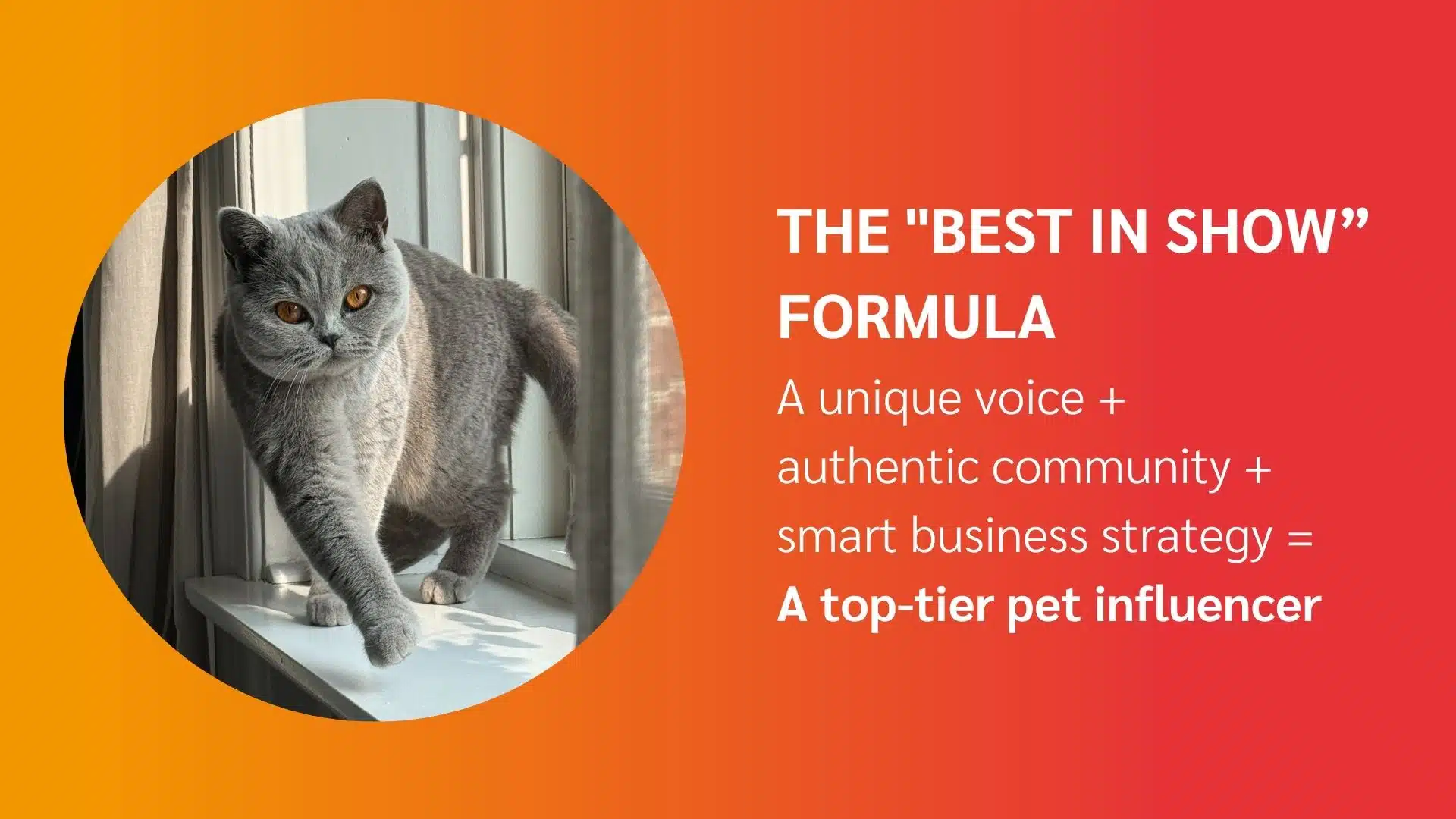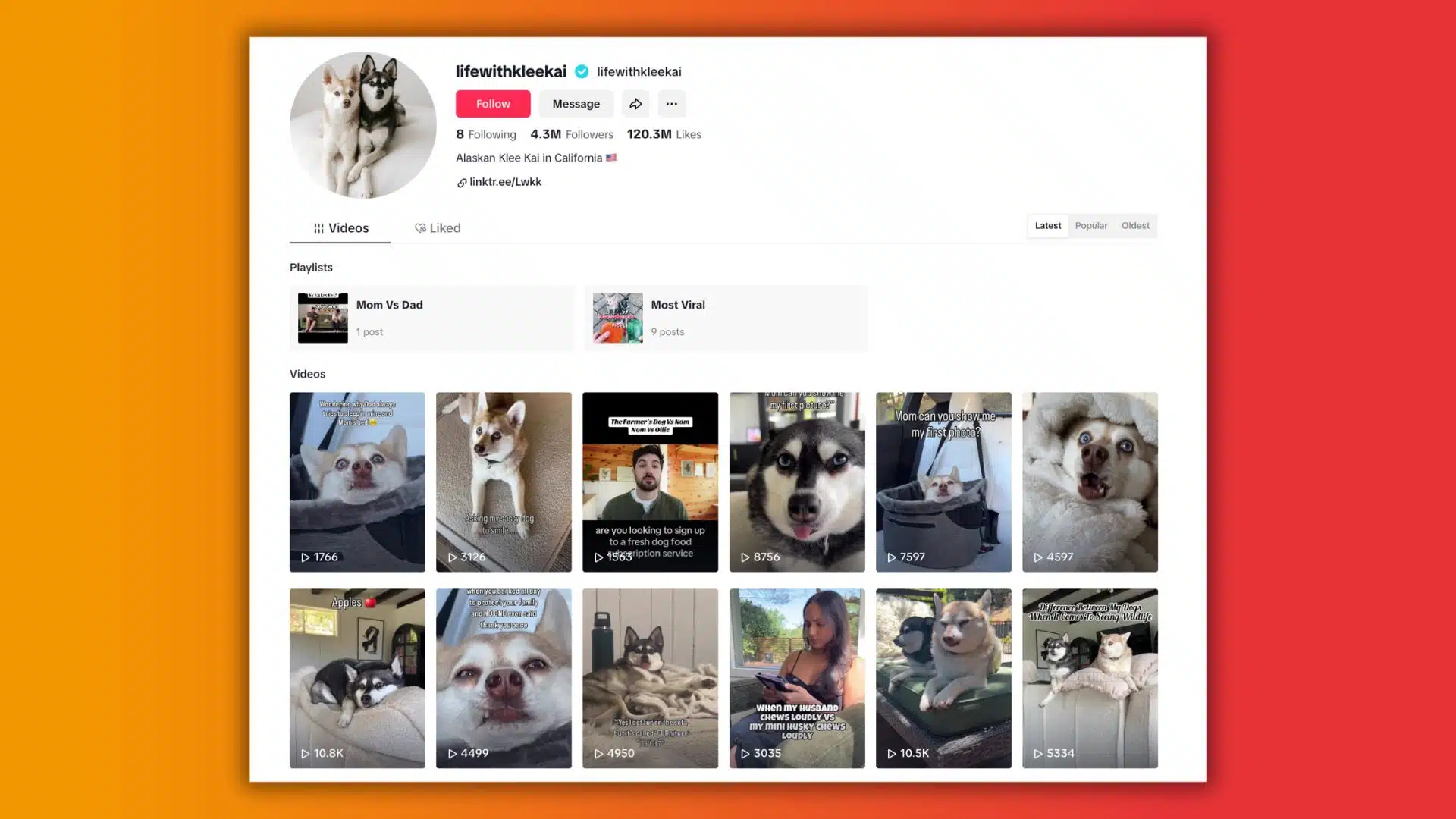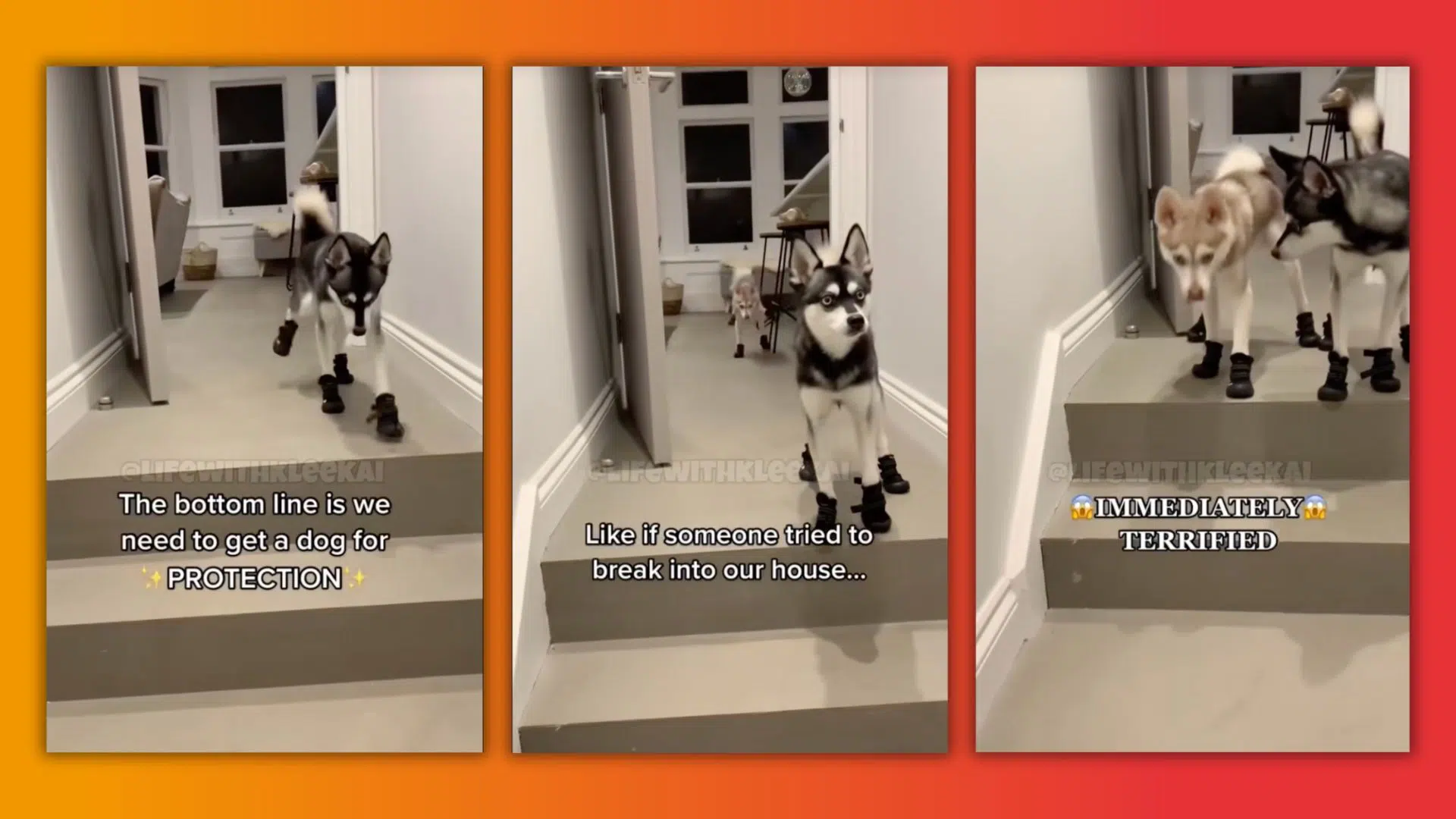In 2020, Bryce and Kenzie—better known as The BK Pets—posted a five-second TikTok in 2020 showing the tiny metal ring they add to reinforce their handmade resin pet-ID tags. Six days later it had amassed 7 million views—and $10,000 in tag sales.
The surge was big enough for both of them to hand in two-week notices and take content creation full-time. Today, their nutrition hacks, DIY tutorials, and answers to common pet food questions help 2.2 million followers on TikTok, YouTube, and Instagram.
Meanwhile, across the Atlantic, Kieran and Yasmin’s Alaskan Klee Kai duo—known as Life With Klee Kai—were transforming their dogs’ sassy personalities into a business: They have 5.6 million followers across their major platforms.
Their rise is part of a much larger wave. Instagram now hosts about two million dedicated pet-influencer profiles, and posts from these accounts average five percent engagement—easily triple the cross-category average for human creators.
The difference between these creators’ success and the thousands of pet accounts stuck at zero isn’t luck or going viral—it’s understanding the strategic elements that separate hobbyist pet social media accounts from professional pet brands that attract lucrative brand partnerships.
This guide breaks down the exact levers The BK Pets and Life With Klee Kai pulled to turn cute clips into sustainable revenue streams so you can replicate their blueprint for your own four-legged star.
The qualities that help pet influencers achieve success and grow a following
A top-tier pet influencer is a furry—or feathered—celebrity who steals hearts, builds a following, and lands brand deals.
The top dogs in this niche face a unique challenge: giving a pet a voice that connects with an audience and keeps them coming back.
It all comes down to listening and creating real opportunities for interaction. The goal is to build a community that crowns them “best in show” time and again.
Cute photos help, but they aren’t enough. The influencers who thrive are the ones who adapt, master new platform features, follow trends, and approach their content like a business.

Choosing your approach: The 2 different pet influencer types
Before you hit record, you need a plan. Not all pet influencers are the same—just like different breeds, they each have their own unique style and niche. Each type connects with audiences in its own way.
This section lays the foundation for picking the angle you’ll take as a pet influencer and the kind of content you’ll create. Once you choose the lane that best fits your pet and personal brand, you can allow it to guide your voice, POV, and content formats going forward.
1. Pet accounts
Whether the story is told through your animal’s “voice” or through your own narration, these profiles keep the pet center-stage.
Some pet accounts narrate their posts entirely from the pet’s point of view using voiceover, giving them a personality their followers love.

Coconut, Fifi, and Poppy Bean (@thebeandogs) often provide peeks into their lives as rescue pups from their point of view.
Others choose to share their lives with pets more broadly, showing the experience of having a pet from the human point of view. Content might look like a camping trip with their dog, a bike ride with their rabbit in a basket, or even just commenting on their cat’s eating habits.
Followers should instantly recognize either the pet’s personality (sass, zoomies, regal calm) or the owner’s distinct commentary.
Pet accounts attract an audience by:
- Sharing everyday moments and mini-stories that other pet parents instantly relate to
- Balancing entertainment with genuine lifestyle glimpses to build emotional resonance
- Establishing trust through a clear, recognizable voice—be it paws-on-keyboard or human narrator

Mika and Mocha’s owner shares content from her perspective but keeps the focus on the beloved cats, creating relatable posts for fellow cat owners.
2. Pet professional accounts
Pet professional accounts are creators who share their hard-earned expertise with the masses. Veterinary professionals, dog trainers, and groomers are perfect examples.
Unlike standard pet accounts, these creators are the face of their accounts. Their content educates pet parents from the point of view of a trusted source of expertise.
Pet professionals are pros at:
- Building trust and credibility with their audience
- Easily explaining complex or health-focused products
- Mixing education with personality to connect with their audience

Greg Echols (@dogter_echols) is a relief veterinarian that uses tongue and cheek humor to educate his audience about pet health and wellness.
Successful pet influencer examples
Let’s take a look at two pet creators who are purrfect performers: Life with Klee Kai and The BK Pets.
Life with Klee Kai
Keiran Beckles and his wife, Yasmin, initially began posting funny videos of their Klee Kai, Skye and Copper. What started as a fun way to share their dogs’ distinct personalities quickly became something their audience craved—and that’s how Life with Klee Kai was born.
They’ve built a loyal pack of followers across TikTok, Instagram, and YouTube Shorts through posting daily clips of their dogs talking and acting out funny scenarios. The content is often relatable, such as finding the dogs napping in a sunny spot or pretending to put them on a diet to get their unfiltered reactions.
Each post builds off a single narrative: there’s never a dull moment with these pups.

Source: Life With Klee Kai
The BK Pets
Bryce and Kenzie Francois of The BK Pets are content creators who understand the concerns of first-time pet parents.
Using their own challenges as inspiration, they help pet owners navigate the confusion of pet food, supplements, and nutrition for their furry friends.
Kenzie adds, “We figured that we couldn’t be the only people in the world that are confused and scared about this. So like, let’s figure it out.”
Their audience loves how their educational content breaks down complicated topics—all while staying relatable.

Source: The BK Pets
Your 7-step guide to becoming a pet influencer and landing high-paying sponsorships
With the right framework in place, your love for your pet can help you grow a platform and audience that trusts your opinions and recommendations.
Follow this step-by-step guide to start sharing relatable moments with your pet, create a loyal following, and deliver real value your audience trusts.
Step 1: Discover your unique niche and passionate voice
Because your pet can’t speak for themselves—and we wish they could—it means you’ll need to give them a little help establishing their voice and narrative.
Start with your “why” to define your unique value proposition. Ask yourself:
- Why are you creating content?
- Why do you want to share?
- What kinds of content do you want to create?
In this video, The BK Pets helps pet parents switch their dogs to a new food without causing digestive issues.
Take The BK Pets. As first-time pet parents, the Francoises searched for tips on caring for their dogs but quickly realized reliable information was hard to come by. Recognizing a need in the market, they quickly filled in the gaps with educational content that pet parents truly value.
At first, this strategy was all about being helpful. In reality, they had found their “unfair advantage.”
This unique perspective becomes the foundation of your content strategy. Once you’ve defined this ‘North Star,’ it naturally informs every aspect of your brand so you can:
- Create your pet’s online persona
- Choose a scalable content angle
- Connect with your audience on a deeper level
This approach gives you a completely fair (and strategic) advantage to become the pick of the litter in your niche.
Bryze and Kenzie explain the magic formula for finding a successful niche: combining your genuine passion for a subject with a unique perspective or “competitive advantage.”
Step 2: Choose your platforms and start consistently creating engaging content
Now that you’ve defined your authentic north star, it’s time to put that vision into action. This stage is all about translating your core principles into a thriving body of content.
Building this strong online presence starts with making strategic choices about where to share your message and how to deliver it consistently.
Find the optimal platforms for your content
While it’s tempting to post on every platform, the key is to be strategic. Think of it like visiting dog parks—you might check out a few at first, but you’ll ultimately focus on the one where your pet feels most comfortable and makes the most friends.
Finding the best social media platform to start with requires a similarly strategic approach. Align your primary content style with a platform’s strengths. If you’re creating short, funny videos, TikTok or Reels are a great fit. In-depth educational content may perform better on YouTube or a blog
Start by testing one or two platforms, post consistently, then analyze your data to see where you’re getting the most traction before expanding.

Life with Klee Kai excels at posting content tailored to the platform, incorporating their fun, entertaining content on platforms like TikTok, YouTube, and Instagram, while publishing their more in-depth content on YouTube and their blog.
Nail down your perfect posting rhythm
Once you’ve chosen the right platforms to focus on, the next step is to find your ideal posting cadence. The best cadence allows you to continuously create high-quality content without burning out.
Consistent content creation helps you:
- Learn what content works
- Build a backlog for new followers
- Establish a reliable presence
The BK Pets initially posted up to fifteen videos a day to learn quickly, showing what’s possible for some creators. However, that pace isn’t for everyone.
A sustainable approach is key to long-term success. To discover your ideal cadence, assess your available time, resources, and energy levels, then experiment with different frequencies to find the sweet spot where quality meets consistency.
The key is to find a pace you can stick with without causing stress to you or your pet.

Focus on crafting engaging content
Once your posting rhythm is set, the real magic happens in crafting content that consistently provides value—whether that’s entertainment, education, or inspiration.
You can do this by:
- Experimenting with different formats. Short videos, stories, high-quality photos, carousels, and tutorials all serve different purposes. Mixing them into your schedule helps you reach a wider audience and gain a stronger following.
- Fostering connection and conversation. Encourage your audience to engage by asking questions, responding to comments, or creating polls and interactive content.
- Ensuring every post has a purpose. Whether it’s to make your audience laugh, teach them something new, or share a beautiful moment, make sure your content provides value. If it doesn’t, it’s just filler.
By consistently applying these strategies, every piece of content becomes a tool for growth.

Step 3: Build your audience through smart community engagement
Building loyal following online is a lot like training a dog—it takes patience, nurturing, consistency, and genuine connection. But, when you listen to your audience, you’re not just adding to your pack. You’re earning trust, driving engagement, and laying the foundation for future monetization opportunities.
To build a thriving pet community, focus on these key strategies.
Prioritize audience interactions
Genuine engagement is the cornerstone of a loyal community. Pay close attention to your audience’s comments and direct messages to build rapport.
How you engage should always be true to your brand. This means understanding your own values and style, even when there are pressures to act a certain way.
While your pet’s unique personality attracts an audience, your authentic interactions on that content builds a lasting bond.
Kieran has seen how deeply his audience connects with his pets’ specific personalities on a human level.
By acknowledging and discussing these relatable traits with your followers, you validate their feelings and strengthen the community connection.
Set aside time each day to respond to comments and direct messages. Staying active in the comments keeps your account warm—a helpful signal for many platforms’ algorithms.
By building a community first, creators establish trust with their audience. Recommendations, like affiliate mentions, are more likely to land as trusted advice from a friend—the more sales, the more revenue.
Connect with other creators in your niche
In the pet niche, other content creators aren’t your competition—they’re your partners in building a stronger community. Building these relationships starts with genuine engagement.
Instead of just following, actively participate in their community by leaving thoughtful comments and sharing their content when it resonates with you.
Once you’ve built a rapport, you can explore more direct collaborations, such as using Instagram’s “Collab” feature on a post, doing a joint Live session, or even just giving each other shout-outs in your Stories.
This strategy does more than just expose you to a new audience—it creates a powerful network effect.

Step 4: Craft a thoughtful cross-platform content strategy
Now that you’ve built a loyal pack and have a strong start on a singular platform, consider branching out.
But picking new platforms you want to branch out into isn’t enough. Like animals, each platform—and their audiences—behaves differently. That doesn’t mean you need a content strategy for each plan. Instead, tweak your content to better fit your audiences’ needs and preferences to build trust and establish a connection.
Here’s what you should do to create and share content across platforms.
Adapt your content for each platform
While it might seem like cross-posting to TikTok, Instagram Reels, and YouTube Shorts is a one-and-done thing, not so fast. Each platform has its own rules and best practices, and audiences are slightly different, too.
Give your content a leg up by tailoring it to meet each platform’s style and following the best practices.
That doesn’t always mean you need to film four versions of the same clip. Instead, use what you have, just think about which kind of content performs well on which platform. A longer video might not get the same engagement on TikTok as it does on Reels or Facebook.
Be an early adopter
One of the best ways to quickly grow a following is to jump on trends as soon as they emerge.
Life with Klee Kai found significant growth by being one of the first to use new features and platforms like TikTok and YouTube Shorts.
Platforms often promote creators who are early adopters. When new features are released, experiment with them early and often.
Stay on top of these new features by:
- Actively following official platform blogs, social media channels, and industry news outlets dedicated to creator updates
- Regularly exploring your app for new icons, tools, or section
- Joining platform beta programs or creator communities when available.
By consistently monitoring these channels, you’ll be among the first to spot new opportunities.
Stay organized
The key to making any content strategy succeed long-term is staying organized. A solid system prevents the stress of last-minute scrambling, allowing you to manage your content schedule and brand partnerships like a professional business.
The BK Pets learned this lesson early on, and quickly started using project management tools to plan and schedule content.
There are plenty of tools online for content management. Find one that:
- Fits your budget
- Is easy to use
- Scales as you grow

Own your audience
One problem with building your community on social media? You’re building on rented land. When platforms experience outages—or potential bans—there’s no way to get in touch with your community.
Additionally, the viral moments most creators chase are short-lived. Once the moment is gone, it can be challenging to regain that audience’s attention—especially if you didn’t have a plan in place.
All of this is why The BK Pets strongly advise to build an email list.
An email list gives you a direct line of communication, independent of social media algorithms or platform issues. Plus, subscribers want to hear from their favorite creators. It helps deepen your community—and provides a built-in platform to amplify your affiliate campaigns.
Bryce and Kenzie explain why creators should prioritize “owning their audience” and how to create those direct and reliable lines of communication.
Step 5: Continue leveling up your content creation skills
Connect with your audience on a deeper level with professionally edited content. The more polished your content, the more likely it is to draw your audience in. In the long-term, this will increase watch times, drive more affiliate link clicks, and generate more interest in your offers.
Consider these strategies.
Look to other creators for inspiration
If you’re unsure what kinds of content your audience prefers, look to other creators. Studying those thriving in your niche, or even outside of it, can help you spot:
- Emerging trends
- Successful formats
- Engaging storytelling techniques
Of course, you shouldn’t copy other creators. Challenge yourself to adapt an idea through your own authentic lens. Referencing your core mission and what kind of content gives you the most traction with your audience allows you to take a more deliberate approach to differentiation.
Refine your visuals
Making time to practice creating better visuals gives you a better chance of capturing authentic moments and making all of your content feel true to you.
Kieran learned this lesson firsthand, noting it was a mistake to use brand-supplied images early in his career.
“We just used photos that brands gave us,” he says. “And now looking back, people were probably like, ‘What’s to say these people actually had the products at all or actually tried them?’”
Taking your own authentic photos, as he does now, is the best way to build trust and show you genuinely use and believe in a product.

Life with Klee Kai’s blog post reviewing Diggs Dog Crate features original photography of how Skye and Copper actually use the item, making the content more interesting while lending credibility.
Hone your storytelling skills
Your social media feed tells an entire story if a picture is worth a thousand words. Beyond photos of your pet sleeping in cute positions, learn to craft a narrative around your pet and their personalities.
Kieran from Life with Klee Kai brings a journalism background to their content, crafting mini-narratives in each post that keep audiences engaged. That storytelling strength also shines on their blog, where product reviews read like guided journeys—pulling readers from the first sentence to the final recommendation.

This TikTok from Life with Klee Kai pairs amusing footage of his dogs waddling in snow boots with audio about getting dogs to protect a home. The combination creates a hilarious contrast that’s guaranteed to get laughs.
The BK Pets offer another powerful approach to storytelling that doesn’t require a special background. They built their brand by authentically documenting their own journey and challenges as first-time pet parents.
Bryce Francois advises creators to lean into these experiences to stand out.
Even if you don’t have a journalism degree or compelling “origin story,” you can still hone your storytelling skills by:
- Defining your pet’s core narrative. Identify 3-4 key personality traits or recurring themes you can use to craft recognizable stories that your audience will come to expect and love.
- Using a simple story structure. Introduce a simple problem (the treat bag is empty), show the struggle (the dramatic pleas for a new one), and deliver the resolution (a trip to the store).
- Invest in your craft with targeted learning. Look for short classes on skills such as mobile video editing, hook writing, or narrative framework.

In this YouTube short, The BK Pets grabs attention with a relatable question many dog owners have asked. They pair it with eye-catching visuals, trending content, and sharp editing inspired by the hit show Severance.
Step 6: Consider how you want to monetize
Pet influencing can be a serious side hustle or a full-time gig—if you monetize it correctly.
If monetizing your content is your goal, explore your options early. While building your audience and creating quality content is primary, think about potential monetization avenues that feel authentic to you and your brand.
Follow these tips.
Diversify your income streams
Take Life with Klee Kai’s advice to heart: steer clear of one income stream.
One income stream can lead to a potential loss of income if something goes wrong. The BK Pets experienced this when their TikTok account was banned, resulting in a loss of access to their shop.
Diversify your income streams by joining each platform’s monetization programs, sharing affiliate links through a blog or storefront, or exploring other options.
Doing this provides more opportunities to make money—and gives you a back up plan if one revenue stream suddenly dries up.
Try to set up monetization streams before you go viral
Viral moments happen—sometimes with content you didn’t think would perform well. And when you do go viral, it means more opportunities for sales.
When a post about resin pet tags went viral for The BK Pets, they earned $10,000 in sales in just six days. But they also learned an important lesson: managing sudden growth can be challenging if your backend systems are lacking.
Take The BK Pets’ advice: create a content library and put basic systems before your viral moment happens.
Laying the groundwork for your email list ahead of virality ensures you’re prepared when an influx of traffic hits your account.
While virality might feel unpredictable, avoid potential snags by maintaining your systems in quiet moments.
Bryce and Kenzie explain that the key to a sustainable career isn’t just achieving virality, but having the right systems in place beforehand to make the most of viral moments.
Step 7: Find best-fit partners
The golden rule of pet partnerships is simple and non-negotiable: only work with brands you believe in and would recommend without payment.
Your followers trust you to be their filter, and they will absolutely sniff out the inauthenticity if a partnership feels forced. If you promote a “tough chewer” toy that your power-chewing pup destroys in five minutes, your credibility will crumble along with it.
Here’s what to do instead.
Ensure partner and product fit
Recommending a product your pet genuinely uses and enjoys helps you remain a trusted source of product recommendations. It should also be a natural fit for your audience and niche.
For instance, if your focus is deep-dive pet nutrition, like The BK Pets, then sponsored posts featuring different pet foods or even selling your own recipe guides becomes a natural fit.
Similarly, if your strength lies in extensive written product reviews, as seen with Life with Klee Kai, affiliate marketing is the perfect model to capitalize on your trusted recommendations.
Determine a brand’s legitimacy and reputation before entering into a partnership contract. Reputation is everything, especially when it comes to working with brands. Look for brands with a strong history, proven success, and a great customer experience.
Kieran shares his process for researching and vetting brands to work with for Life With Klee Kai.
Pitch brands directly
Don’t wait for sponsorship opportunities to come to you. Research shows that only 5 percent of brands want to actively recruit and source creators.
One of the best ways to stand out is to email your pitch directly to brand contacts instead of sliding into their DMs—another pitch approach backed by research.
The BK Pets suggests making it easy for brands to work with you by presenting fully fleshed-out content ideas.
Demonstrate your value by:
- Crafting a strong pitch email that shows how your content could elevate their brand
- Including a strong media kit that highlights important engagement metrics such as likes, comments, and shares
- Keeping your rate card close by so you’ll have a number in mind when it’s time to negotiate
This shows the brand that you’re a strategic partner committed to the campaign’s success—ensuring it’s easy for them to say yes.

3 examples of pet influencer brand partnerships in action
If you’re just thinking about becoming a pet influencer, seeing brand partnerships in action is helpful. Use these real partnerships as inspiration for your own influencer journey.
The BK Pets x Open Farms
The BK Pets’ collaboration with Open Farm is a perfect example of how sponsorship opportunities work. In a sponsorship, a brand pays the creator a flat fee to produce and share content featuring their product or service.
For creators, the biggest advantage of a sponsored post is guaranteed income. This payment model provides a predictable fee that compensates you for your time, creative labor, and the access you provide to your community.
In this post, The BK Pets’ primary job is to educate their audience about the product in a way that feels genuine and trustworthy. Think of it like an authentic commercial delivered straight to your audience’s social feeds.

See the post: The BK Pets
Why it works
This post is effective because it perfectly integrates the product into The BK Pets’ core brand identity, which is built on education and trust.
The partnership feels authentic because it aligns with their established niche. The BK Pets have built their platform on educating pet parents about nutrition and clean ingredients, so collaborating with a brand like Open Farm feels like a natural extension of their content—not a disruptive ad.
Watching the video, the audience clearly sees a happy pup gobbling up dinner. Bryce’s focus is on educating his audience about the new food line over making a hard sell.
This, combined with his genuine excitement about the contents of the food, makes the message land as a passionate recommendation from a trusted expert instead of a scripted pitch.

Source: The State of Influencer Marketing for Consumers
Life with Klee Kai x Farmer’s Dog and Tally’s Ranch
Affiliate marketing gives pet influencers an easy way to earn money by sharing products they genuinely love with their audience. This approach lets them focus on creating valuable content that keeps generating revenue long after it’s published.
Here’s how it works: creators share trackable links to the products they recommend. When someone clicks and buys, the creator earns a commission. This strategy often pairs well with discounts to encourage clicks and purchases.
For example, Life with Klee Kai’s blog post comparing The Farmer’s Dog and Tally’s Ranch dog foods helps readers make smart purchase decisions while acting as a trusted resource.

See the post: Life with Klee Kai
Why it works
Life with Klee Kai are affiliate marketing pros—and this blog post shows it.
They know the common challenges their audience of devoted dog owners often face: “Which premium food is best for my picky pup?” By directly comparing two popular brands in one post, they capture high-intent search traffic from people who are ready to make a purchase.
The post also builds unshakable trust through authenticity. When readers see the pets they follow actually using the products, the review transforms from an advertisement into a genuine recommendation from a trusted peer.
Additionally, the monetization is seamless and reader-focused. Instead of just dropping links, they offer valuable discounts, turning the affiliate click into a direct benefit for the reader. By fairly representing both brands, they build credibility and can earn a commission no matter which product the reader chooses, making it a win-win.

Source: The State of Influencer Marketing for Consumers
Freya the Fluff x PetSmart
Freya the Fluff’s partnership with PetSmart is the perfect example of a hybrid partnership.
Hybrid deals blend sponsored content and affiliate marketing. You make a post in your feed that follows a traditional sponsored content format, while also sending traffic to that brand’s affiliate links. This allows you to get paid both a flat fee and commissions.
In this example, Freya’s sponsored post from PetSmart directs people to a curated storefront filled with products their cats love.

See the post: Freya the Fluff
Why it works
Freya the Fluff’s PetSmart partnership is framed as a simple, relatable story: the toy bin and treat stash are empty, so it’s time for a shopping haul. This narrative approach makes the content feel less like an ad and more like a fun, authentic peek into the cats’ lives, immediately drawing the audience in.
The product recommendations also feel genuine because they’re specific. By mentioning “all-time favorite lickable treats” and a “cozy new bed,” the post suggests these are items the cats truly love and use. This builds trust and gives followers a real reason to visit the storefront—they want to buy the same things their favorite fluff uses.
From a monetization perspective, Freya secures a guaranteed flat fee for creating the sponsored post. They create an opportunity for long-term passive income through commissions, maximizing the earning potential of a single post.

Source: The State of Influencer Marketing for Consumers
Unleash your pet’s star potential
Building a pet influencer brand takes more than sharing high-quality photos of your furry friend. It’s all about blending strategy, storytelling, and content creation with a business mindset. Whether you’re sharing silly videos, training tips, or product reviews, each post does the heavy lifting to elevate your pet’s brand and attract potential collaborations.
If you’re just starting out in pet influence, remember this: build with your community with intention, let your pet be the star, and the opportunities will follow.
Thank you to our contributing experts. Follow The BK Pets on YouTube, Instagram, and TikTok. You can also follow Life With Klee Kai on YouTube, Instagram, and TikTok.
For more tips on content creation and brand partnerships, check out these other resources:
- A content creator’s guide to making money [2024] (blog)
- 6 ways creators can elevate their personal brand with brand collaborations (blog)
- How to earn big with affiliate marketing for influencers with Maryandpalettes (blog)
FAQs
Being a pet influencer allows you to turn your love for your pet into a rewarding side hustle—or even a full-time business. Beyond income, it creates community, opens doors to brand collaborations, and gives you a platform to educate and inspire other pet owners. Your pet gets plenty of extra treats, attention, and belly rubs.
There are a variety of platforms you can choose from to find brand collabs. Start by joining creator marketplaces like the impact.com Marketplace, where brands seek pet creators to work with. Many pet brands offer affiliate programs and influencer campaigns where you can apply directly. Building your audience and content library will also attract brands organically over time.
Pet influencer income varies widely. Small creators may start with free products or smaller affiliate commissions, while larger accounts with strong engagement can earn thousands per month through brand deals, affiliate sales, digital product sales, and more monetization methods.
Building a successful pet influencer brand from scratch involves several key, strategic steps.
- Define your unique “why” to establish a passionate voice and a clear niche for your brand
- Create engaging, valuable content consistently on a primary platform where your target audience is most active
- Prioritize building a loyal community by interacting with your audience and connecting with other creators to foster trust
- Explore monetization strategies and brand partnerships that feel authentic to your values once you have an engaged following
Above all, always remember that your pet is a companion first, ensuring their comfort and happiness remains the top priority throughout your journey.
Building a personal brand for your pet is a lot like building one for yourself, but with a furry twist.
- Start by defining your pet’s “why” to establish a passionate voice and clear niche. Ask yourself what perspective your pet brings that others might not have.
- Craft a narrative around your pet’s personality and experiences, creating a “story” that your audience will love and come to expect.
This unique narrative, combined with an authentic voice, will be your competitive advantage.
Once you’ve established your pet’s brand, focus on creating content that provides value, whether it’s entertainment, education, or inspiration. Experiment with different formats like short videos, high-quality photos, and carousels to see what resonates with your audience.
Most importantly, be consistent and actively engage with your community. By prioritizing audience interactions and building trust, you’ll lay a strong foundation for future brand partnerships and long-term success.
Eventually, you’ll want to consider aligning your brand partnerships with your pet’s personal brand.
What mistakes should new pet influencers avoid to ensure their financial success? Here are a few:
- Underestimating the need for strategy: Successful pet influencers approach their content strategically by defining a unique niche, creating a content plan, and consistently delivering value.
- Neglecting to build a loyal community: Instead of solely relying on “going viral,” build a loyal audience and a strong community.
- Focusing on too many platforms at once: Be intentional, choosing one or two platforms that fit your content and audience, and then adapting your content to match the tone and format of each one.
- Not diversifying income streams: Relying on a single platform or revenue stream is risky and can lead to financial stress. Instead, explore multiple income streams like brand deals, affiliate marketing, and selling digital products to build more sustainable income.
- Failing to vet brand partnerships: New influencers must only partner with brands that are a natural fit for their pet and audience to maintain credibility and trust.
- Waiting for brands to reach out: New influencers should proactively pitch brands directly with well-thought-out content ideas.
- Building on “rented land”: Platforms can have outages or algorithm changes, so. It’s advised to build an email list to have a direct line of communication with your audience.








